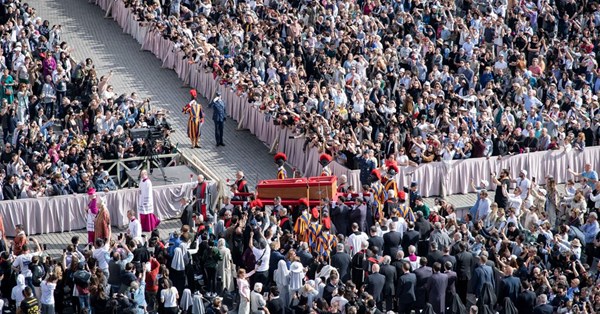TENS of thousands of pilgrims flocked to Rome this week, before the funeral of Pope Francis, who died, aged 88, early on Easter Monday.
His remains have been transferred from the ground-floor chapel of the Casa Santa Marta to St Peter’s Basilica, to lie in state, so that the public may pay their respects, until his funeral on Saturday. The same day, he will become the first pope to be laid to rest outside the Vatican City since Leo XIII in 1903: his resting place will be in St Mary Major (Santa Maria Maggiore) in Rome. The rite of translation of the body took place in the Vatican on Wednesday morning, led by the College of Cardinals.
There are currently 252 cardinals from more than 90 countries, of whom 135 are eligible to vote in the forthcoming conclave, at a date yet to be confirmed, to elect a new pope. More than 100 of the voting cardinals were appointed by Pope Francis during his 12-year papacy. Cardinals above the age of 80 are not eligible to vote.
The Pope’s death was announced in a statement from the Camerlengo of the Apostolic Chamber, Cardinal Kevin Farrell, at about 9 a.m. on Easter Monday.
“At 7:35 this morning (local time), the Bishop of Rome, Francis, returned to the house of the Father. His entire life was dedicated to the service of the Lord and His Church,” it read. “With immense gratitude for his example as a true disciple of the Lord Jesus, we commend the soul of Pope Francis to the infinite merciful love of the One and Triune God.”
On Monday evening, the Vatican identified the cause of death as a stroke, followed by a coma and irreversible cardiocirculatory collapse.
The director of the Directorate of Health and Hygiene of the Vatican City State, Dr Andrea Arcangeli, issued the official certification, which was released by the Holy See Press Office. The Pope, it reported, had a previous history of acute respiratory failure caused by multimicrobial bilateral pneumonia, multiple bronchiectases, high blood pressure, and Type 2 diabetes. His death was confirmed through electrocardiographic thanatography.
Pope Francis had been limiting his public activities since he was discharged from the Gemelli Hospital, in Rome, on Sunday 23 March, where he had been recovering from respiratory illnesses. He had been undergoing treatment since 14 February, when he was diagnosed with bilateral pneumonia. His condition was initially not reported to be life-threatening, but he later experienced “an asthma-like respiratory crisis of prolonged intensity”, and received a blood transfusion.
Twice-daily statements on his condition were being released by the Holy See press office, and his condition was reported to remain “complex” and the prognosis “guarded”, until his release.
After 38 days in hospital, the Pope returned to his Vatican residence at the Casa Santa Marta to continue his recovery.
On Easter Day, he made a brief visit to St Peter’s Basilica, a couple of hours before the Easter vigil, to greet the faithful. His homily was delivered by Cardinal Giovanni Battista Re, presiding on his behalf. In it, the Pope “reminds us that the light of the Resurrection illumines our path”.
The Vatican has since reported that Pope Francis had been apprehensive about this public appearance, asking his former nurse, appointed his personal health-care assistant in 2022, Massimiliano Strappetti, “Do you think I can manage it?” After greeting crowds of 50,000 in the popemobile, including babies and children, Pope Francis later told Mr Strappetti: “Thank you for bringing me back to the Square.”
On his final hours, the Vatican reports: “The Pope then rested on Sunday afternoon and had a quiet dinner. Around 5.30 a.m., the first signs of the sudden illness appeared, prompting an immediate response from those keeping watch over him.
“Around an hour later, after making a gesture of farewell with his hand to Mr Strappetti, lying in bed in his second-floor apartment at the Casa Santa Marta, the Pope fell into a coma. According to those who were with him in his final moments, he did not suffer. It all happened quickly.
“His was a discreet death, almost sudden, without long suffering or public alarm, for a Pope who was always very reserved about his health.”
Born Jorge Mario Bergoglio, in Buenos Aires, Argentina, in 1936, he was the first Pope to have come from the Jesuit order, and the first since the eighth century to have been born or raised outside Europe. He was inspired to join the Jesuits in 1958 after recovering from severe illness. He was ordained priest in the Roman Catholic Church in 1968. He became Archbishop of Buenos Aires in 1998, and was created a cardinal in 2001 by Pope John Paul II.
After the resignation of Pope Benedict XVI, on 28 February 2013, Archbishop Bergoglio was elected by a papal conclave, choosing his name in honour of St Francis of Assisi. Throughout his public life, Pope Francis was known for taking a less formal approach to the papacy — last year, he approved a simplified papal funeral — and for his humility, emphasis on mercy, and concern for the poor and for interreligious dialogue.
During his papacy, he made women full members of dicasteries in the Roman Curia, and maintained that the Church should be more sympathetic to the LGBT community. He was also vocal on issues such as global diplomacy, care for creation, and the future of AI.
Millions of visitors were expected to converge on Rome this year — a Jubilee Year, with religious and cultural events highlighting and fostering Christian commitment.

















